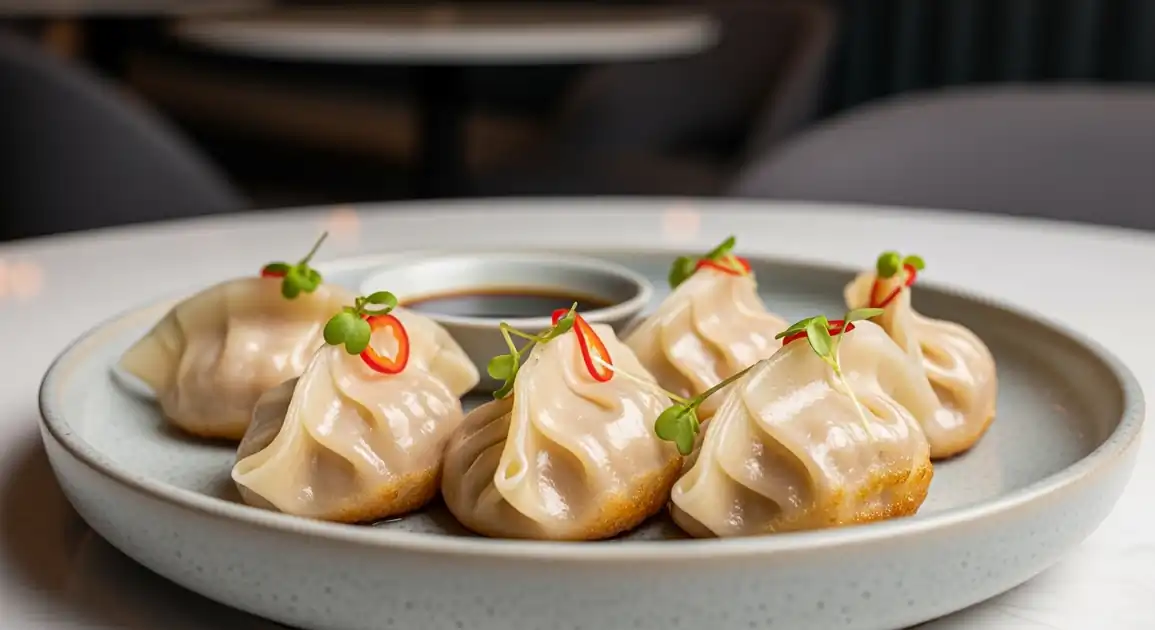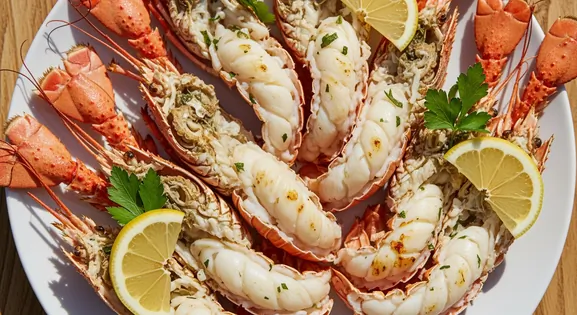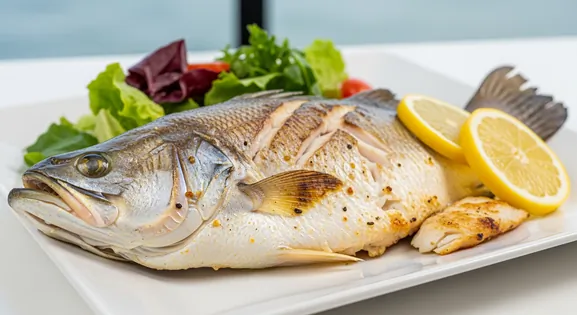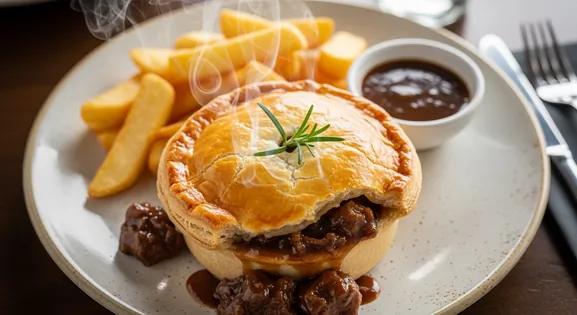Barramundi Dumplings in Australia: A Complete Food Lover's Guide
Barramundi Dumplings

A Culinary Snapshot
Barramundi Dumplings are a sophisticated appetizer or small plate representative of modern Australian cuisine. They feature succulent, locally sourced Barramundi fish, finely minced or flaked, and typically seasoned with a blend of Asian aromatics such as ginger, garlic, scallions, soy sauce, and sesame oil. Encased in delicate dumpling wrappers, they are skillfully prepared either by steaming for a tender texture or pan-frying for a delightful contrast of crispy bottoms and soft tops.
History and Origins
Unlike traditional dumplings with long histories, Barramundi Dumplings are a contemporary culinary creation. They emerged from Australia's dynamic food scene, where innovative chefs blend global influences (especially Asian) with high-quality local ingredients. Using Barramundi, a popular and sustainable Australian fish, in this format showcases the nation's culinary innovation and its embrace of fusion cuisine.
Deconstructing Barramundi Dumplings: Ingredients and Method
Fresh Barramundi fillet is typically minced or finely flaked. It's mixed with seasonings which might include ginger, garlic, spring onions, coriander, soy sauce, sesame oil, white pepper, and sometimes egg white or cornstarch as a binder. Small portions of the filling are placed onto round dumpling wrappers (usually wheat-based). The wrappers are folded and pleated to enclose the filling securely. Dumplings are then either steamed until cooked through or pan-fried (often with a little water added to steam the tops) until the bottoms are golden and crispy.
Key Ingredients of Barramundi Dumplings
Barramundi Fillet
This lean, white-fleshed fish is native to Australia and provides a delicate, slightly sweet flavor. It's chosen for its firm texture that holds up well in dumplings.
Quality indicator: Look for fillets that are firm, moist, and have a fresh, mild scent, indicating high quality.
Dumpling Wrappers
Typically thin, round, wheat-based wrappers that encase the filling. Their delicate nature allows the filling to shine while providing a satisfying chew.
Quality indicator: Quality wrappers should be pliable, not sticky or brittle, and cook evenly without tearing.
Asian Aromatics (Ginger, Garlic, Scallions)
These fresh ingredients provide the foundational savory and pungent notes that balance the fish and give the dumplings their distinctive flavor profile.
Quality indicator: Aromatics should be fresh, fragrant, and finely minced to distribute flavor evenly throughout the filling.
Local Barramundi Dumplings Variations in Australia
Steamed Barramundi Dumplings
Dumplings are cooked solely by steaming, resulting in a soft, delicate texture.
Pan-Fried Barramundi Dumplings
Cooked like potstickers – fried on the bottom until crispy, then steamed to cook through.
Dumplings with Broth
Sometimes served in a light, flavorful broth instead of with a dipping sauce.
Different Dipping Sauces
Sauces can vary widely, from simple soy-vinegar mixes to more complex chili oil, black vinegar, or creamy sauces.
Filling Additions
Some chefs might add complementary ingredients like chopped prawns, water chestnuts, shiitake mushrooms, or different herbs to the barramundi filling.
The Perfect Accompaniments
Light Lager or Pale Ale
Beer
A crisp, light lager or a refreshing pale ale cuts through the richness of pan-fried dumplings and complements the delicate fish flavor without overpowering it.
Sauvignon Blanc or Pinot Grigio
Wine
A dry, crisp white wine with citrus notes, like a Sauvignon Blanc or Pinot Grigio, provides a refreshing contrast to the savory dumplings and enhances the Barramundi's natural sweetness.
A Traveler's Guide to Authenticity
What to Look For
-
Dumplings served hot, indicating fresh preparation.
Ensures the dumplings have been cooked recently and to a proper internal temperature for optimal quality.
-
Fish filling cooked through (opaque and flaky).
Ensures proper doneness for optimal enjoyment. The filling should not be raw or translucent.
-
Reputable restaurant with good hygiene ratings/reviews.
Choosing established restaurants known for quality and cleanliness supports a positive dining experience.
-
Fresh taste and smell of the fish filling.
The Barramundi should taste clean and fresh, not overly fishy or off-putting.
What to avoid
-
Dumplings served lukewarm or cold.
May indicate they were not freshly cooked or reheated properly.
-
Any signs of undercooked fish (translucency) or dough.
Do not consume if the filling or wrapper appears raw.
-
Off-smells or sour taste indicating spoilage.
Trust your senses; if the dumplings taste or smell bad, stop eating.
-
Restaurants with visibly poor hygiene.
Avoid establishments where the kitchen or serving areas appear unclean, as this can compromise the quality and enjoyment of your meal.
Explore Barramundi Dumplings in Detail: City Guides
Discover where to find the best Barramundi Dumplings and learn local tips in these cities:
Dietary Information
Dietary Information
Important Note for Travelers: Your safety is our priority. Below are the common allergens associated with the traditional preparation of this dish. However, recipes and ingredients can vary significantly between establishments. Always confirm all ingredients directly with the food vendor before ordering, especially if you have a severe allergy.
Potential Allergens
Dietary Suitability
How to Order Barramundi Dumplings
Frequently Asked Questions about Barramundi Dumplings
What are Barramundi Dumplings?
Barramundi Dumplings are a modern Australian dish, typically featuring minced or flaked Australian Barramundi fish mixed with Asian-inspired seasonings (like ginger, garlic, soy, herbs) enclosed in a dumpling wrapper. They are usually served steamed or pan-fried as an appetizer or small plate.
What do Barramundi Dumplings taste like?
They taste primarily of the delicate, slightly sweet flavor of Barramundi, enhanced by savory and aromatic notes from ingredients like ginger, garlic, soy sauce, and possibly chili or fresh herbs like coriander. The texture depends on preparation – soft and tender if steamed, with a crispy bottom if pan-fried.
How can I ensure quality when eating Barramundi Dumplings?
When prepared correctly in a reputable restaurant, Barramundi dumplings are a delightful choice. Look for fresh Barramundi, verify signs of proper cooking (fish is opaque and flaky, wrapper is cooked), and observe good kitchen hygiene.
Where did Barramundi Dumplings originate?
This specific dish doesn't have deep historical roots but is a product of modern Australian cuisine, which often fuses European techniques with Asian flavors and utilizes local Australian produce like Barramundi. It reflects Australia's multicultural culinary landscape.
How do I order Barramundi dumplings in a restaurant?
When ordering, you can specify if you prefer them steamed or pan-fried, if the menu offers both options. You might also ask about the accompanying dipping sauce. Most restaurants serve them as an appetizer or small plate, so consider how many servings you might need.
Are Barramundi Dumplings gluten-free or vegetarian?
No, they are typically not gluten-free as most dumpling wrappers are made from wheat flour, and soy sauce often contains wheat. They are also not vegetarian because the core ingredient is Barramundi fish. Always confirm with the restaurant if you have specific dietary needs.
Expert How-To Guides about Barramundi Dumplings
How to Identify Quality Barramundi Dumplings
Learn to recognize the signs of expertly prepared Barramundi dumplings, ensuring a delicious and authentic culinary experience when dining out.
- Wrapper Integrity: The wrappers should be intact, not torn or falling apart.
- Filling Texture: The barramundi filling should be moist and flaky, not dry or mushy.
- Flavor Balance: Flavors should complement the fish, not overpower it. Look for fresh aromatic notes.
- Cooking Execution: Steamed dumplings should be tender; pan-fried ones should have a crispy (not burnt) bottom.
- Sauce Pairing: The dipping sauce should enhance, not drown, the dumpling's flavor.
Eating Dumplings Etiquette (Restaurant Setting)
Navigate the dining experience with confidence by understanding the common etiquette for enjoying dumplings in a restaurant setting.
- Use chopsticks or a fork, whichever you are comfortable with.
- Pour a small amount of dipping sauce into your individual small dish, if provided.
- Dip one end of the dumpling lightly into the sauce; avoid soaking it completely.
- Eat the dumpling in one or two bites.
- If sharing, use the serving utensils provided to move dumplings to your plate.
Our Commitment to Quality
At Tasteplorers, our mission is to provide the most accurate and useful travel information in the world. To achieve this, all content on this site is created through our unique editorial framework. We utilize leading AI research tools, guided by our proprietary prompts, and a multi-stage validation process. This entire system is overseen by our editorial team to ensure everything we publish meets our high standards for accuracy, cultural nuance, and practical value for travelers.
Learn more about our Editorial Process and our Mission.
Explore regions
Europe
Discover Europe's diverse culinary landscape, from Mediterranean flavors to hearty Alpine fare. Learn to navigate markets, decode menus, and eat like a local.
Latin America & Caribbean
Discover the vibrant cuisines of Latin America & the Caribbean. Our expert guide covers everything from Mexican street food to Peruvian ceviche and market tips.
Oceania
Explore Oceania's diverse food scene. Learn about Polynesian earth ovens, Fijian feasts, and the vibrant café culture of Australia and New Zealand.
Southeast Asia
Explore Southeast Asia's diverse food cultures from Thailand to Vietnam. Get expert tips on navigating spice levels, choosing quality vendors, and understanding the rich traditions of the region.






